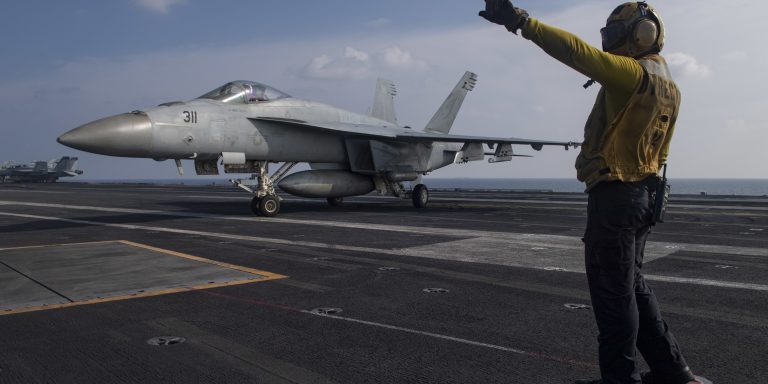INTELBRIEF
July 7, 2021
IntelBrief: U.S. – Iran Proxy War in Iraq Escalates

Bottom Line up Front
- The Biden administration is escalating deterrent U.S. attacks on Iran-backed Iraqi militias, risking an expanded and protracted U.S.-Iran conflict.
- The Biden administration’s policy is similar to the Trump administration’s approach in subordinating Iraq policy to a broader effort to roll back Iran’s regional influence.
- The Iraqi government is failing in its efforts to rein in Iran-backed militias that operate outside the Iraqi command structure.
- Iran is arming its allies with increasingly sophisticated drones and rocket technology that pose a significant threat to U.S. and coalition forces in Iraq.
A United States-Iran proxy conflict inside Iraq appears to be escalating, approaching levels last seen in 2019 during the height of the implementation of the Trump administration’s “maximum pressure” strategy against Iran. On June 28, U.S. President Joseph Biden authorized airstrikes against three targets straddling the Iraq-Syria border, including two inside Syria and one inside Iraq. U.S. military officials said the sites bombed were linked to earlier drone attacks on U.S. forces in Iraq, launched by the Iran-backed militia groups Kata’ib Hezbollah and Kata’ib Sayyid al-Shuhada. Iran sponsors several such militia groups as part of its effort to shore up the embattled regime of President Bashar Al Assad. The Iran-backed militia groups said that four of their members were killed in the June 28 attacks. In retaliation, American troops patrolling northeast Syria—as part of the ongoing U.S. effort against the so-called Islamic State (ISIS)—came under rocket fire from Iran-backed groups operating in that country, prompting U.S. forces in Syria to respond with artillery fire against the rocket launching positions. The combat, near eastern Syria’s al-Omar oil field, did not result in any U.S. injuries.
Since President Biden took office, Iran-backed Iraqi militias have attacked U.S. forces and personnel in Iraq with at least five armed drone strikes and as many as twenty-four rocket and missile volleys. Press reports indicate that the drones Iran is supplying to its allies in Iraq are increasingly sophisticated, homing in on their targets with preset GPS coordinates—an advance over the remotely-controlled and less effective drones Iran has supplied in prior years. On July 5, hours after rockets launched by Iran-backed militias fired on Iraq’s Ayn al-Asad base where U.S. forces operate, the United States shot down one of these drones as it tried to attack the U.S. Embassy in Baghdad. The following evening, July 6, another attempted drone attack occurred, this time targeting Erbil airport, though Coalition authorities reported no casualties or damage. Nevertheless, three separate attacks over the course of 36 hours is a clear indication of an increase in operational tempo on the part of the militias.
The June 28 U.S. strikes appear to represent a departure by the Biden administration from its early positions as well as from those of the Trump administration. The June strike differed from a similar incident in February, in which U.S. aircraft struck Iran-backed Iraqi militia targets over the border in Syria, where they maintain weapons depots and other facilities. That attack avoided striking inside Iraq in order not to complicate Iraqi Prime Minister Mustafa al-Kadhimi’s efforts to balance Iraq’s relations with the United States with those of neighboring Iran. Following the June 28 strike, U.S. Secretary of State Antony Blinken said that President Biden is “fully prepared to act and act appropriately and deliberately to protect U.S. interests,” if Iran-backed militia continue to attack American forces in the region. This stance contrasts with that of the Trump administration, which retaliated against Iran-backed forces only if their attacks caused loss of life.
On the other hand, the Biden administration stance continues a different aspect of Trump administration strategy: subordinating Iraq policy to the overall U.S. battle with Iran for regional influence. The U.S. strike inside Iraq went ahead despite its potential to complicate Prime Minister al-Kadhimi’s attempts to limit the influence and autonomy of Iranian proxies in Iraq. A spokesman for Kadhimi criticized the U.S. strike inside Iraq as “a blatant and unacceptable violation of Iraqi sovereignty and Iraqi national security.” Indicative of the degree to which Kadhimi has thus far failed to reduce the influence of Iran and its proxies in Iraq, he attended a June military parade by Shia militia forces, including Iran-backed groups, at a base in the east of the country. In recent months, armed militia maneuvers intimidated Kadhimi to release militia commanders who were arrested in connection with abuses against Iraqi human rights and political activists. Reining in the militias is likely to form a pivotal component of discussions between President Biden and Kadhimi when the prime minister visits Washington in late July.
The challenge for the Biden administration is to deter additional Iran-backed attacks without producing a protracted and expanded conflict with Iran that could potentially spill over into other parts of the region and involve U.S. allies. U.S.-Iran clashes during the Trump administration included Iranian attacks on and seizures of international shipping in the Persian Gulf, including tankers owned by the Gulf Arab monarchies. An expanded U.S.-Iran conflict could derail talks in Viennatoward a mutual U.S. and Iranian return to full compliance with the 2015 multilateral Iran nuclear agreement. Iran might opt to try to retaliate against the U.S. and its allies through terrorist attacks in the region, in Europe, or elsewhere. Any prolonged U.S.-Iran conflict is almost certain to derail the Administration’s efforts to refocus U.S. military resources to threats posed by other great powers like Russia and China. Escalating clashes with Iran could also bring the Administration into a confrontation with the U.S. Congress over presidential authority to take military action without specific congressional authorization.